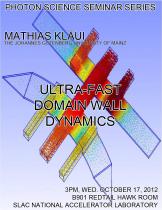Mathias Kläui, The Johannes Gutenberg University of Mainz
Since conventional approaches of manipulating magnetization using magnetic fields exhibit unfavourable scaling and results in limited switching speed, alternative approaches based on spin-currents have emerged.
The transfer of angular momentum (“spin transfer torque effect”) leads for instance to current-induced domain wall motion (CIDM), which has become the focus of intense research in the last few years. We have comprehensively investigated CIDM and determined the acting adiabatic and non-adiabatic torque terms [1]. We find that the previously neglected diffusive torque term [2] can play an important role for vortex core displacement. For out-of-plane magnetized Co/Pt a large non-adiabatic torque is found, while in Co/Ni the adiabatic torque dominates [3]. Concurrently we also measure the domain wall magnetoresistance effect in nanoconstrictions and correlate the observed large effects with the structure.
By separating charge and spin transport we can generate pure diffusive spin currents with no associated net charge current. Using such diffusive spin currents we find large efficiencies for domain wall displacement due to strong spin accumulation absorption [4]. To increase the spin diffusion length, we use robust turbostratic graphene and find spin injection across transparent contacts.
Beyond generating spin currents by spin injection, we have also used the Spin Seebeck Effect, where temperature gradients generate spin currents that then affect for instance domain wall propagation [5] and using Free Electron Laser sources we measure the ultra-fast magnetization dynamics due to superdiffusive spin currents [6].
References:
[1] L. Heyne et al., Phys. Rev. Lett. 105, 187203 (2010); M. Eltschka et al., Phys. Rev. Lett. 105, 056601 (2010).
[2] A. Manchon, W.-S. Kim, and K.-J. Lee, arXiv:1110.3487





